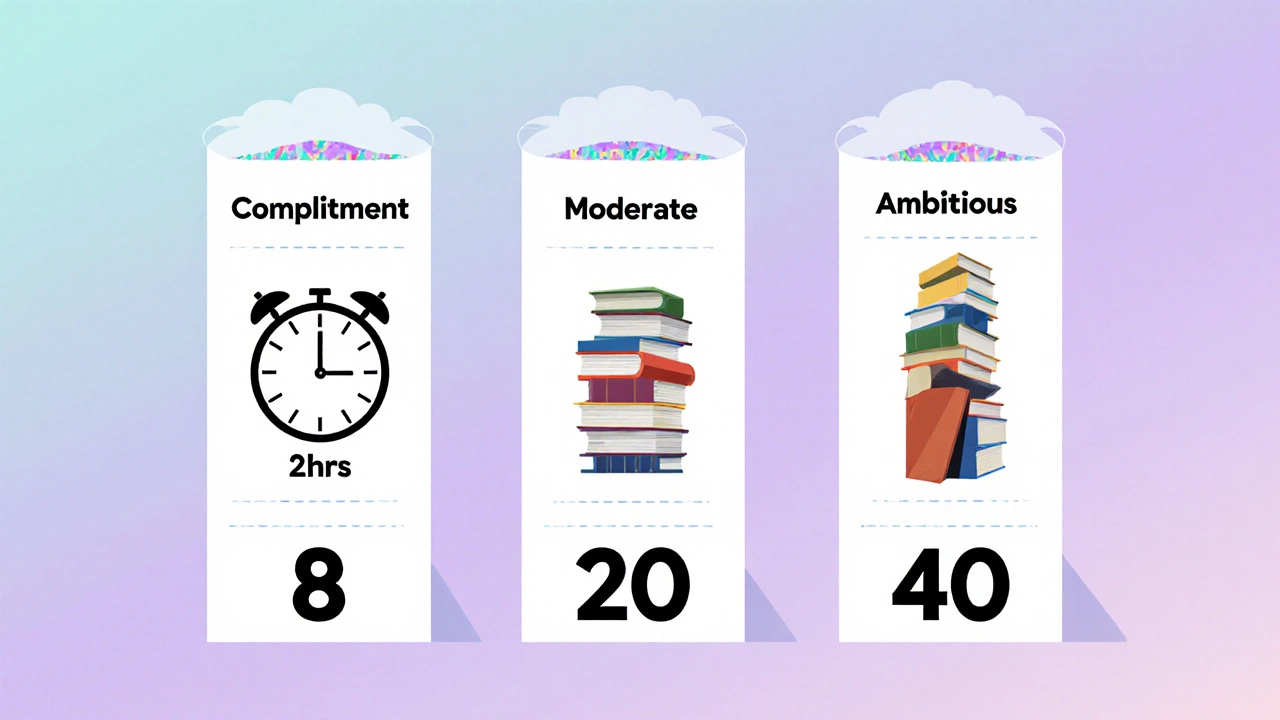Beginner Reading Goal Calculator
This calculator helps beginners estimate how many books they should aim to read in a year based on their reading capacity.
Your Estimated Annual Reading Goal
If you’ve just started a reading habit, the biggest question is often: how many books should a beginner read in a year? The answer isn’t a one‑size‑fits‑all number; it depends on your schedule, reading speed, and the type of books you enjoy. Below you’ll find a step‑by‑step guide to figure out a realistic goal, sample plans for different paces, and tips to keep the momentum going.
Figure Out Your Personal Reading Capacity
Start by estimating three key variables:
- Reading speed is the number of pages you can comfortably read in an hour. Most adults average 200-300pages per hour, but beginners often start closer to 150pages.
- Available time - count the minutes you can realistically devote to reading each day. Even 15minutes a day adds up.
- Average book length - most fiction novels sit around 300pages, while many non‑fiction titles hover near 250pages.
Multiply your weekly reading minutes by your reading speed, then divide by the average page count. The formula looks like this:
(Weekly minutes ÷ 60) × Reading speed ÷ Average pages per book = Approximate books per year
For example, if you can read 30minutes a day (210minutes a week) at 150pages per hour, you’ll cover 525pages weekly. With a 300‑page average, that’s roughly 1.75books per month, or about 21books a year.
Sample Reading Plans for Different Paces
Not everyone can stick to the same schedule. Below are three typical plans - low, moderate, and ambitious - each with a clear weekly time commitment.
| Plan | Weekly Reading Time | Avg. Pages per Book | Total Books per Year | Ideal For |
|---|---|---|---|---|
| Low‑Commitment | 2hours | 250pages | 8books | Busy professionals, casual readers |
| Moderate | 5hours | 300pages | 20books | Students, part‑time workers |
| Ambitious | 10hours | 300pages | 40books | Full‑time readers, book‑club regulars |
Pick the plan that feels doable. If you’re unsure, start with the low‑commitment option and adjust as you get comfortable.

Choose Books That Keep You Hooked
Reading a dozen boring textbooks won’t help you build a habit. Here’s how to pick titles that fuel momentum:
- Genre matters more than length. If you love mystery, start with short thrillers (200‑250pages). Fantasy fans might enjoy series where each installment is a bite‑size adventure.
- Mix fiction with non‑fiction. A biography or self‑help guide can provide practical takeaways while still feeling like a story.
- Leverage local resources. Your nearest library often has reading‑challenge lists, new‑arrival shelves, and staff picks that are curated for starters.
- Consider audiobooks for commutes. They count toward your total pages and let you “read” while driving or exercising.
Make a shortlist of 10-15 books that spark curiosity. As you finish each one, add another title from the same author or genre to keep the flow smooth.
Track Progress and Tweak the Goal
Setting a target is only half the battle; monitoring it turns intention into achievement.
- Use a simple spreadsheet: columns for Book title, start date, finish date, page count, and rating.
- Log weekly reading minutes. If you fall short for two consecutive weeks, reduce the yearly goal by 10% to stay realistic.
- Celebrate milestones. Finishing the first three books is a perfect moment to reward yourself with a new bookmark or a coffee out.
- Re‑evaluate every quarter. Ask yourself whether your chosen reading schedule still matches your lifestyle, and adjust the number of books accordingly.
Tracking not only shows progress but also reveals patterns-maybe you read faster in the evenings or struggle with dense academic texts. Use that insight to refine your next reading plan.

Common Pitfalls and Pro Tips
Even the best‑intentioned beginners stumble. Here’s a quick cheat‑sheet of what to avoid and what to do instead:
- Choosing only long, complex books. Start with shorter, engaging reads to build confidence.
- Setting an unrealistic yearly target. A goal that feels impossible leads to quitting. Aim for a 20% buffer.
- Neglecting variety. Sticking to one genre can cause fatigue. Rotate between fiction, memoir, and practical guides.
- Skipping tracking. Without data you can’t see improvement. Even a quick note in a phone app helps.
- Not allocating dedicated time. Treat reading like any other appointment-block it on your calendar.
Pro tip: Pair reading with another habit you already have. If you brew coffee every morning, read a chapter while the coffee brews. The cue‑routine‑reward loop makes the habit stick.
Frequently Asked Questions
What is a realistic number of books for a total beginner?
For most total beginners, 8-12 books in the first year feels achievable. That averages to one book a month, which fits into even a busy schedule without causing burnout.
How can I speed up my reading without losing comprehension?
Practice active reading: highlight key points, jot quick summaries, and ask yourself questions after each chapter. Over time, these habits improve both speed and retention.
Should I focus on fiction or non‑fiction first?
Choose what excites you most. Fiction often feels less demanding, making it a great entry point. If personal growth is a priority, blend in short non‑fiction titles to keep the habit balanced.
Is it okay to reread books during my first year?
Absolutely. Rereading reinforces concepts and can boost confidence. Just log it as a separate entry if you want to track total books read.
How do I stay motivated when I hit a reading slump?
Switch genres, try an audiobook, or join a local book club. Changing the format or discussing the story with others often reignites interest.
